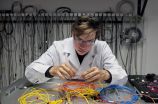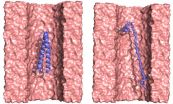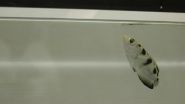(Press-News.org) NEW YORK, NY - Patients with scoliosis who undergo surgery may be less likely to develop an infection or other complications after the procedure when a novel wound closure technique pioneered at NYU Langone Medical Center is utilized, according to new research. The study was published online this past July in the Journal of Pediatric Orthopaedics.
In this new technique, surgeons use a multilayered flap closure that enables doctors to close several layers of muscle and fascia while maintaining blood supply from the donor site to the recipient site. The researchers believe this new method reduces complication rates by eliminating "dead space," or pockets around spinal hardware and fusion sites where infection can start. The technique also creates a better barrier to separate surgical hardware and bone grafts from the skin's surface.
"This game-changing method for closing incisions after surgery can benefit all patients with scoliosis, especially those most at risk for complications depending on the cause of their spine problems," says corresponding study author David S. Feldman, MD, professor of orthopaedic surgery and pediatrics at NYU Langone. "All of our patients with scoliosis - from the basic to most complex cases - can feel confident knowing their safety is our top priority."
A conventional, non-standardized closure method after scoliosis surgery often involves a bulk skin closure performed by an orthopaedic surgeon where no flaps are mobilized.
In this retrospective study, NYU Langone researchers reviewed 76 charts of patients aged 8 to 25 years, with non-idiopathic scoliosis - a type of scoliosis caused by an underlying syndrome or neuromuscular disease -- who had undergone a posterior spinal fusion surgery. Forty-two patients had their incisions closed using conventional techniques, while 34 underwent the new, multilayered flap technique.
Approximately 19 percent of patients who underwent the conventional, non-standardized closure methods experienced a wound complication, which was in line with previous estimates of infection rates for people with non-idiopathic scoliosis. However, patients who underwent the novel, multilayered muscle flap closure method experienced a 0 percent complication rate.
The new closure method has been increasingly used at NYU Langone since 2009, and is a collaborative effort between the Departments of Orthopaedic Surgery and Plastic Surgery.
"The success of this procedure speaks to our Medical Center's commitment to collaborate with other medical specialties to ensure our patients receive optimal patient care," says senior study author Michael S. Margiotta, MD, assistant professor of plastic surgery and neurosurgery at NYU Langone.
Scoliosis is a disorder in which there is an S-shaped or C-shaped, sideways curve of the spine. Severe cases are often treated with spinal fusion surgery, where a surgeon will repair the abnormal curving of the spine by fusing steel rods, hooks, screws or other metal devices to straighten the spine and support the bones of the spine. Bone grafts are placed to hold the spine in the correct position and prevent it from curving again.
In most people with scoliosis, there is no known cause for this curve, which is known as idiopathic scoliosis. However, a small subset of scoliosis cases are non-idiopathic, meaning the curvature was caused by an underlying disease, such as a neurological condition like cerebral palsy. These patients are between 25 and 76 percent more likely to experience complications following spinal fusion surgery and between 4 and 23 percent more likely to have an infection, compared to those with idiopathic scoliosis. This is because these patients are generally sicker and more likely to experience complications overall. Patients with idiopathic scoliosis face a lower complication rate at 1 to 2 percent of cases.
These infections can be debilitating to patients and their families, and place significant burdens on the health care system through follow-up wound care, additional treatments or possible surgical procedures.
But until now, there has been little published about the best technique for spinal wound closure after surgery to prevent complications for patients, especially those at highest risk due to scoliosis caused by an underlying condition.
"There was a time when complex scoliosis cases, including revision surgery, had infection rates approaching double digits," says study co-author Thomas Errico, MD, chief of the Division of Spine Surgery at NYU Langone. "We have now lowered infection rates to under 1 percent, a remarkable accomplishment thanks to attention to detail and teamwork of the dedicated surgeons in our Orthopaedic Surgery and Plastic Surgery departments."
INFORMATION:
More information: "Wound Closure in Nonidiopathic Scoliosis: Does Closure Matter?"
Post-discharge disease management provided in their own homes could be a cost-effective alternative for recently-hospitalised elderly patients with chronic heart failure (CHF).
Just published in the International Journal of Cardiology, this is the finding of a recent economic evaluation conducted by Griffith University using data from a randomised controlled trial (The WHICH Study).
In collaboration with the Australian Catholic University, 280 patients with CHF recruited from three public hospitals, received multidisciplinary disease management.
With the aim of reducing ...
The solid waste left over from wine-making could make a competitive biofuel, University of Adelaide researchers have found.
Published in the journal Bioresource Technology, the researchers showed that up to 400 litres of bioethanol could be produced by fermentation of a tonne of grape marc (the leftover skins, stalks and seeds from wine-making).
Global wine production leaves an estimated 13 million tonnes of grape marc waste each year. Nationally it is estimated that several hundred thousand tonnes are generated annually and it is generally disposed of at a cost to ...
The problem has been that the vast majority of these atomically thin 2D crystals are unstable in air, so react and decompose before their properties can be determined and their potential applications investigated.
Writing in Nano Letters, the University of Manchester team demonstrate how tailored fabrication methods can make these previously inaccessible materials useful.
By protecting the new reactive crystals with more stable 2D materials, such as graphene, via computer control in a specially designed inert gas chamber environments, these materials can be successfully ...
In the Arctic, warming increases like a spiral. Global warming means that the periods of growth are becoming longer and vegetation growth is increasing. At the same time, heat transfer to the Arctic from lower latitudes is rising, reducing sea ice there, and this in turn is contributing towards a faster local rise in temperature.
A new research study published in the highly respected research journal PNAS shows that the situation is the reverse on the Tibetan Plateau.
Vegetation on the Tibetan Plateau has also increased as a result of global warming. However, in contrast ...
A team at the University of Warsaw, Faculty of Physics has created a laser capable of generating ultrashort pulses of light even under extremely difficult external conditions. This unique combination of precision and resilience is due to the fact that the whole process of generating femtosecond laser pulses takes place within a specially-selected optical fiber.
Its appearance seems quite inconspicuous: just a flat, rectangular box, tens of centimeters across and about the same height, with a thin, shiny-tipped "thread" leading out of it, so long that it is rolled up ...
University of Pennsylvania researchers have made strides toward a new method of gene sequencing a strand of DNA's bases are read as they are threaded through a nanoscopic hole.
In a new study, they have shown that this technique can also be applied to proteins as way to learn more about their structure.
Existing methods for this kind of analysis are labor intensive, typically entailing the collection of large quantities of the protein. They also often require modifying the protein, limiting these methods' usefulness for understanding the protein's behavior in its natural ...
Move over, Katniss Everdeen. For archerfish, the odds are ever in their favor, according to new research from Wake Forest University.
The sharp-shooting fish's ability to spit water to hit food targets has been well documented, but a new study published online in the journal Zoology showed for the first time that there is little difference in the amount of force of their water jets based on target distance. And, when given the choice, the fish preferred closer targets.
The study was co-authored by Wake Forest researchers Morgan Burnette, a biology graduate student, ...
A new study says that global warming has measurably worsened the ongoing California drought. While scientists largely agree that natural weather variations have caused a lack of rain, an emerging consensus says that rising temperatures may be making things worse by driving moisture from plants and soil into the air. The new study is the first to estimate how much worse: as much as a quarter. The findings suggest that within a few decades, continually increasing temperatures and resulting moisture losses will push California into even more persistent aridity. The study appears ...
COLUMBUS, Ohio - Formula One racing teams may have a lesson to teach business leaders: Innovation can be overrated.
That's the conclusion from academic researchers who pored over data from 49 teams over the course of 30 years of Formula One racing. They found that the teams that innovated the most - especially those that made the most radical changes in their cars - weren't usually the most successful on the race course.
Moreover, radical innovations were the least successful at exactly the times when many business leaders would be most likely to try them: when there ...
A research team at York has adapted the astonishing capacity of animals such as newts to regenerate lost tissues and organs caused when they have a limb severed.
The research, which is funded by a £190,158 award from the medical research charity Arthritis Research UK, is published in Nature Scientific Reports.
The scientists, led by Dr Paul Genever in the Arthritis Research UK Tissue Engineering Centre in the University's Department of Biology, have developed a technique to rejuvenate cells from older people with osteoarthritis to repair worn or damaged cartilage ...



